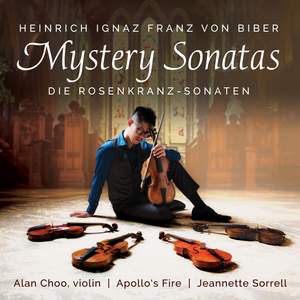The Mystery Sonatas by Austrian composer Heinrich Ignaz Franz von Biber, believed to have been penned in the 1670s, remain unsurpassed for their virtuosity and extended use of scordatura, a unique tuning system that underscores different aural colours and timbres of the violin, thereby illuminating the pictorial themes of the Rosary - the processions devoted to major moments in the lives of Christ and the Virgin Mary - which Biber's work depicts.
Singaporean violinist Alan Choo, the vibrant leader of acclaimed baroque ensemble Apollo's Fire, headlines a dynamic and descriptive recording of the Mystery Sonatas, enhancing the scordatura with six different violins that require 15 individual tunings. He explains, "The use of a unique scordatura tuning for each sonata means that a violinist needs to use multiple violins if performing several of the pieces in the same week - each violin kept at the tuning of its respective sonata. Otherwise, the constant re-tuning of a violin would destabilize its tuning. I used a total of six violins in this recording. The personality of each instrument shines through."
Joined by a chamber ensemble of his Apollo's Fire colleagues, including founding director Jeannette Sorrell on harpsichord, Choo navigates Biber's extended techniques with aplomb and devotion to the 15 programmatic sonatas which are compiled into three cycles - the Joyful Mysteries (the Angel Gabriel delivers the news to Mary that she will be the mother of the Messiah), Sorrowful Mysteries (Jesus' agony, knowing he is about to be betrayed) and Glorious Mysteries (the Resurrection of Christ and his ascent to heaven) - and are crowned by the timeless finale, Passacaglia for solo violin.





